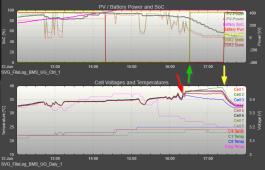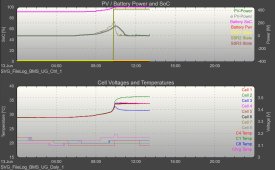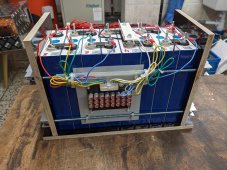Hi folks,
As i managed to fully charge my new and shiny 8S 105Ah LFP battery for the first time today (beside top-balancing), i noticed a strange behavior: as soon as the Victron SmartSolar charger switched from bulk charging to absorption, the cell voltages of the battery started drifting apart rapidly.
First i want to mention that i have very battery-friendly charger settings:
Absorption Voltage: 3.45V/cell --> 27,6V
Float Voltage: 3.35V/cell --> 26,8V
Absorption Time: 1h
Now here's what happened:

Red arrow --> charger switched to absorption.
Green arrow --> active balancer (5A capacitive) kicked in due to cell diff reaching configured threshold of 40mV
Yellow arrow --> i manually switched on a higher load (added 65W to the previous 25W)
This is the first full charge of the battery since top-balancing it, which is at least 2 months ago. Since then, the battery was partially discharged and within the last 4 days partially charged and discharged.
What seems quite strange to me is that although the balancer was enabled, cell 2 voltage kept rising whereas cell 3 voltage kept falling - my thought on that is that the time span was probably too short for the balancer to do it's job before i "forced" all the cells down to (nearly) float voltage with the higher load?
As a first "counter measure" i've decided to decrease the differencial voltage threshold at which the balancer is being enabled, so my active balancing starts under the following conditions:
* at least one cell has reached 3.4V
* the cell diff between highest and lowest cell is at least 10mV (was 40mV before)
* balancer is disabled as soon as the first cell has less than 3.3V
Meanwhile (2 hours later) the battery pack is back to a cell diff of 4mV at a pack voltage of 26.5V (97% SOC reported by Victron SmartShunt).
Do you think that there is anything i can (or should) do about that? Or is it perfectly normal the way it is?
Any hints on this topic welcome
thanks in advance and have a nice day,
Juergen
As i managed to fully charge my new and shiny 8S 105Ah LFP battery for the first time today (beside top-balancing), i noticed a strange behavior: as soon as the Victron SmartSolar charger switched from bulk charging to absorption, the cell voltages of the battery started drifting apart rapidly.
First i want to mention that i have very battery-friendly charger settings:
Absorption Voltage: 3.45V/cell --> 27,6V
Float Voltage: 3.35V/cell --> 26,8V
Absorption Time: 1h
Now here's what happened:

Red arrow --> charger switched to absorption.
Green arrow --> active balancer (5A capacitive) kicked in due to cell diff reaching configured threshold of 40mV
Yellow arrow --> i manually switched on a higher load (added 65W to the previous 25W)
This is the first full charge of the battery since top-balancing it, which is at least 2 months ago. Since then, the battery was partially discharged and within the last 4 days partially charged and discharged.
What seems quite strange to me is that although the balancer was enabled, cell 2 voltage kept rising whereas cell 3 voltage kept falling - my thought on that is that the time span was probably too short for the balancer to do it's job before i "forced" all the cells down to (nearly) float voltage with the higher load?
As a first "counter measure" i've decided to decrease the differencial voltage threshold at which the balancer is being enabled, so my active balancing starts under the following conditions:
* at least one cell has reached 3.4V
* the cell diff between highest and lowest cell is at least 10mV (was 40mV before)
* balancer is disabled as soon as the first cell has less than 3.3V
Meanwhile (2 hours later) the battery pack is back to a cell diff of 4mV at a pack voltage of 26.5V (97% SOC reported by Victron SmartShunt).
Do you think that there is anything i can (or should) do about that? Or is it perfectly normal the way it is?
Any hints on this topic welcome
thanks in advance and have a nice day,
Juergen
Last edited:





